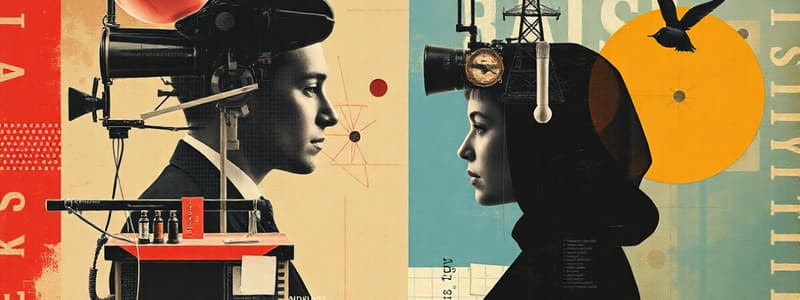Podcast
Questions and Answers
What is one of the key components of Aristotle’s Modes of Persuasion?
What is one of the key components of Aristotle’s Modes of Persuasion?
- Ethos (correct)
- Pathos (correct)
- Phatic communication
- Laswell Model
How is communication described in relation to its irreversibility?
How is communication described in relation to its irreversibility?
- It leaves a lasting impression once spoken. (correct)
- It can easily be taken back by the speaker.
- It requires the listener to respond immediately.
- It is primarily controlled by non-verbal cues.
In the context of communication, what does the term 'symbols' refer to?
In the context of communication, what does the term 'symbols' refer to?
- Representations used to express thoughts and feelings. (correct)
- Formal written communications.
- Verbal cues only.
- Physical tokens used in communication.
Which component is NOT part of the Laswell Model of communication?
Which component is NOT part of the Laswell Model of communication?
What role does phatic communication play in interactions?
What role does phatic communication play in interactions?
What does it mean when communication is described as proactive?
What does it mean when communication is described as proactive?
Which statement reflects a common misconception about communication?
Which statement reflects a common misconception about communication?
What is a key component added to the Shannon-Weaver Model that affects communication?
What is a key component added to the Shannon-Weaver Model that affects communication?
What is meant by saying that meaning in communication is individually construed?
What is meant by saying that meaning in communication is individually construed?
In Schramm's Model, what roles do communicators adopt?
In Schramm's Model, what roles do communicators adopt?
Which type of noise is related to external factors that distract the listener?
Which type of noise is related to external factors that distract the listener?
What does the field of experience influence in communication models?
What does the field of experience influence in communication models?
Which type of noise is characterized by ambiguous language?
Which type of noise is characterized by ambiguous language?
What is a significant difference between the Shannon-Weaver Model and interactive models of communication?
What is a significant difference between the Shannon-Weaver Model and interactive models of communication?
What fundamental components are included in Berlo's Model of Communication?
What fundamental components are included in Berlo's Model of Communication?
Which of the following statements accurately describes Wood's Transactional Model of Communication?
Which of the following statements accurately describes Wood's Transactional Model of Communication?
In the context of communication noise, what does physiological noise refer to?
In the context of communication noise, what does physiological noise refer to?
Which model of communication emphasizes the roles of encoder, interpreter, and decoder?
Which model of communication emphasizes the roles of encoder, interpreter, and decoder?
What aspect did Berlo add to his model to give it a human dimension?
What aspect did Berlo add to his model to give it a human dimension?
Which of the following best describes the main characteristic of transactional models of communication?
Which of the following best describes the main characteristic of transactional models of communication?
In Eugene White's model, what is a key feature of effective oral communication?
In Eugene White's model, what is a key feature of effective oral communication?
Which of the following is NOT a basic element in Berlo's SMCR model?
Which of the following is NOT a basic element in Berlo's SMCR model?
What role do the skills, attitudes, knowledge, social systems, and culture play in Berlo's model?
What role do the skills, attitudes, knowledge, social systems, and culture play in Berlo's model?
Who developed the Speech Communication Transaction Model?
Who developed the Speech Communication Transaction Model?
Which element of communication refers to the recipient of the message?
Which element of communication refers to the recipient of the message?
What does the term 'encoding' refer to in the context of communication?
What does the term 'encoding' refer to in the context of communication?
Which of the following is NOT considered a barrier to effective communication?
Which of the following is NOT considered a barrier to effective communication?
In the context of the 7 C's of Effective Communication, which aspect emphasizes respect for the audience's values?
In the context of the 7 C's of Effective Communication, which aspect emphasizes respect for the audience's values?
What does 'context' refer to in the elements of communication?
What does 'context' refer to in the elements of communication?
Which of the following attributes does NOT belong to the 7 C's of Effective Communication?
Which of the following attributes does NOT belong to the 7 C's of Effective Communication?
What role does communication play in decision-making according to the functions of communication?
What role does communication play in decision-making according to the functions of communication?
Which of the following components is responsible for producing and sending a message in communication?
Which of the following components is responsible for producing and sending a message in communication?
What factor does NOT influence how communication resolves conflict?
What factor does NOT influence how communication resolves conflict?
Which of the following best describes communication as a process?
Which of the following best describes communication as a process?
Which model of communication is characterized as a one-way process?
Which model of communication is characterized as a one-way process?
What does NOT characterize the Aristotelian Model of Communication?
What does NOT characterize the Aristotelian Model of Communication?
Which statement is true about communication?
Which statement is true about communication?
How does the context play a role in communication?
How does the context play a role in communication?
What element is NOT part of the communication process?
What element is NOT part of the communication process?
What does communication not typically achieve in its simplest form?
What does communication not typically achieve in its simplest form?
Flashcards are hidden until you start studying
Study Notes
Defining Communication
- The exchange of information, concepts, and opinions between individuals, regardless of context
- A continuous process involving multiple factors
- Systemic, meaning it is part of a larger system with its own patterns
- Involves communicators who actively create meaning
- Irreversible, as any message sent has lasting consequences
- Proactive, as both communicators actively analyze the message and the sender's credibility
- Symbolic, as symbols are used to express thoughts and feelings
- Meaning is individually interpreted through experiences and schemas
Communication Myths
- Communication doesn't always require complete understanding
- Communication cannot always solve conflict
- No single person or event solely determines another's reaction
- Communication is complex and not always simple
Models of Communication
Linear Models
- One-way process where the message travels in a single direction
- Examples include: Aristotle's Model, Laswell's Model, Shannon-Weaver Model, Berlo's Model
Aristotle's Model
- Speaker-centered model, where the speaker holds control
- Focuses on the speaker, the message (logos, pathos, ethos) and the audience
- Commonly observed in public speaking
Laswell's Model
- Five components: who (communicator), says what (message), through what channel (medium), to whom (receiver), with what effect (effect)
- Includes channel (print media, broadcast media)
Shannon-Weaver Model
- Includes noise, which can disrupt the flow of communication
- Includes the information source, transmitter, receiver, destination, and noise
Berlo's Model
- Known as the SMCR model (Source, Message, Channel, Receiver)
- Includes human dimension in the channel, with the 5 senses involved in decoding
- Suggests that the source and receiver are influenced by skills, attitudes, knowledge, social systems, and culture
Interactive Models
- Recognizes the receiver's role in communication
- Two-way process with feedback involved
- Examples: Schramm's Model, White's Model
Schramm's Model
- Communicators take on the roles of encoder, interpreter, and decoder
- Focuses on the overlap in field of experience between communicators (culture, social background, beliefs, experiences, values, rules)
White's Model
- Recognizes feedback as a part of the communication process
- Presents a sequential and cyclical communication process
- Includes 8 stages of oral communication
Transactional Models
- Communicators exchange messages simultaneously
- Most accurate model
- Examples: Wood's Transactional Model, Speech Communication Transaction Model
Wood's Transactional Model
- Communication viewed as a dynamic process
- Communicators are influenced by context, background, and relationships
- Feedback can be verbal or nonverbal
Speech Communication Transaction Model
- Includes 7 elements: the speaker, listeners, message feedback, channel, situation, and cultural context
- Situation refers to the physical environment and social context
- Cultural context deals with the cultural rituals, rules, and norms
Functions of Communication
- Control: Used to manage the behavior of individuals in an organization
- Social Interaction: Communication facilitates social connections and relationships
- Motivation: Used to encourage individuals to achieve goals
- Emotional Expression: Allows for sharing of thoughts and feelings
- Information Dissemination: Provides information for decision-making and problem-solving
7 C's of Effective Communication
- Completeness: Includes all necessary information
- Conciseness: Direct and to the point
- Consideration: Takes into account the receiver's needs and background
- Concreteness: Backed by facts, figures, and examples
- Courtesy: Shows respect for the receiver's values and beliefs
- Clearness: Uses simple and specific language
- Correctness: Demonstrates proper grammar usage
Elements of Communication
- Speaker: Originator of the message
- Message: Information transmitted by the speaker
- Encoding: Converting thoughts into a communicable form
- Context: The setting of the communication
- Channel: The medium used to transmit the message
- Barriers: Obstacles to effective communication
- Receiver: Recipient of the message
- Decoding: Interpreting the received message
- Feedback: Receiver's response to the message
Oral Communication
- This refers to the act of communicating using words
- It is an active process of sending and receiving information
- Requires effective listening and speaking skills
- It is influenced by various factors including:
- Culture
- Social context
- The individual's emotions and beliefs
- Oral communication is a vital part of human interaction and plays a crucial role in building relationships, sharing information and influencing others.
Studying That Suits You
Use AI to generate personalized quizzes and flashcards to suit your learning preferences.




